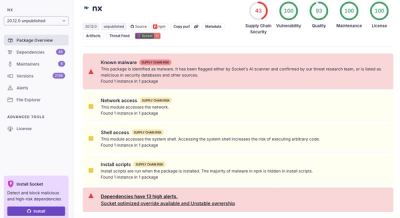
Security News
Risky Biz Podcast: Making Reachability Analysis Work in Real-World Codebases
This episode explores the hard problem of reachability analysis, from static analysis limits to handling dynamic languages and massive dependency trees.
= WebFinger
An Ruby WebFinger client library.
Following the latest WebFinger spec discussed at IETF WebFinger WG. http://tools.ietf.org/html/draft-ietf-appsawg-webfinger
If you found something different from the latest spec, open an issue please.
== Installation
Add this line to your application's Gemfile:
gem 'webfinger'
And then execute:
$ bundle
Or install it yourself as:
$ gem install webfinger
== Usage
=== Basic
You can discover resource metadata.
WebFinger.discover! 'acct:nov@connect-op.heroku.com' WebFinger.discover! 'connect-op.heroku.com' WebFinger.discover! 'http://connect-op.heroku.com'
You can also specify link relations via "rel" option.
WebFinger.discover! 'acct:nov@connect-op.heroku.com', rel: 'http://openid.net/specs/connect/1.0/issuer' WebFinger.discover! 'acct:nov@connect-op.heroku.com', rel: ['http://openid.net/specs/connect/1.0/issuer', 'vcard']
=== Caching
Caching is important in HTTP-based discovery.
If you set your own cache object to WebFinger.cache, this gem caches the discovery result until it expires.
(the expiry is calculated based on the "expires" value in JRD response)
WebFinger.cache = Rails.cache
WebFinger.discover! 'acct:nov@connect-op.heroku.com' # do HTTP request WebFinger.discover! 'acct:nov@connect-op.heroku.com' # use cache, no HTTP request
=== Debugging
Once you turn-on debugging, you can see all HTTP request/response in your log.
WebFinger.debug!
WebFinger.logger = Rails.logger
You can also specify URL builder to force non-HTTPS access. (NOTE: allow non-HTTPS access only for debugging, not on your production.)
WebFinger.url_builder = URI::HTTP # default URI::HTTPS
== Contributing
git checkout -b my-new-feature)git commit -am 'Add some feature')git push origin my-new-feature)== Copyright
Copyright (c) 2012 nov matake. See LICENSE for details.
FAQs
Unknown package
We found that webfinger demonstrated a not healthy version release cadence and project activity because the last version was released a year ago. It has 1 open source maintainer collaborating on the project.
Did you know?

Socket for GitHub automatically highlights issues in each pull request and monitors the health of all your open source dependencies. Discover the contents of your packages and block harmful activity before you install or update your dependencies.

Security News
This episode explores the hard problem of reachability analysis, from static analysis limits to handling dynamic languages and massive dependency trees.

Security News
/Research
Malicious Nx npm versions stole secrets and wallet info using AI CLI tools; Socket’s AI scanner detected the supply chain attack and flagged the malware.

Security News
CISA’s 2025 draft SBOM guidance adds new fields like hashes, licenses, and tool metadata to make software inventories more actionable.